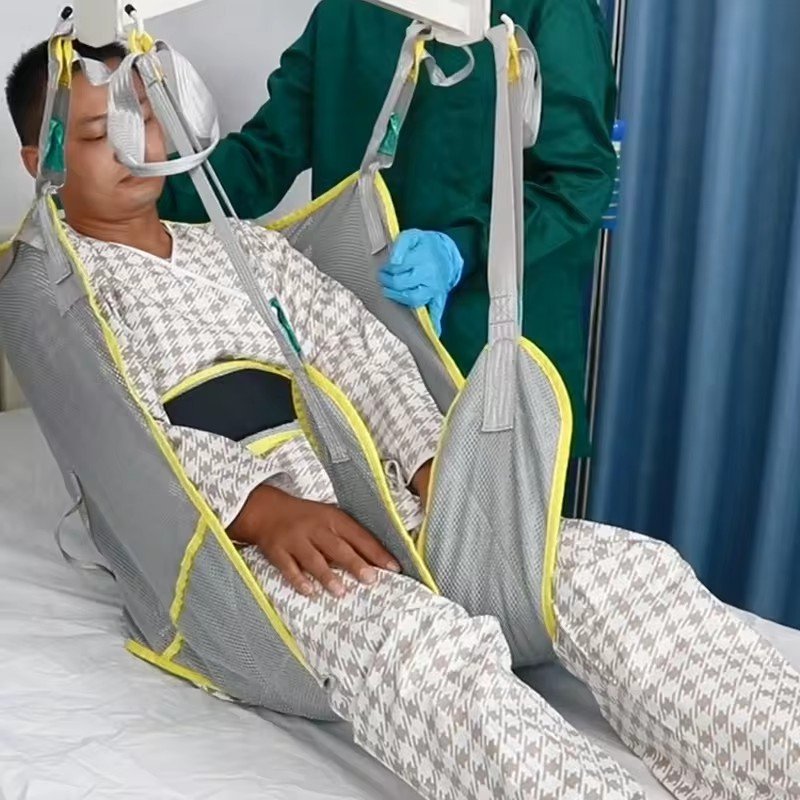Transfer slings are essential components of safe patient handling systems, acting as the critical link between a mechanical lift and the individual being transferred. While they might appear deceptively simple, a significant amount of engineering and material science goes into creating a sling that is safe, comfortable, and effective. This deep dive explores the key aspects of transfer sling materials, design, and how these elements contribute to their vital functionality in modern healthcare and caregiving.
1. The Foundation: Materials Science Behind Transfer Slings
The choice of material is fundamental to a transfer sling’s performance, durability, and safety. Slings must be strong enough to bear significant weight, comfortable for the patient, and resistant to wear and tear, as well as cleaning processes. Common materials include:
- Polyester: A very common and versatile material. Polyester slings are known for their strength, durability, resistance to stretching, and relatively quick drying time. They are a reliable choice for general-purpose slings.
- Nylon: Similar to polyester in strength and durability, nylon is also known for its smooth surface, which can contribute to easier application and removal, particularly when sliding the sling beneath a patient.
- Mesh: Often used for bathing or toileting slings, mesh material is highly breathable, allows water to drain easily, and dries quickly. While still strong, the open weave provides less continuous surface area than solid fabrics.
- Specialized Synthetics: Some manufacturers use proprietary blends or coated fabrics to enhance specific properties, such as increased slickness for easier application, anti-microbial properties, or enhanced breathability.
Material properties like tensile strength (resistance to breaking under tension), abrasion resistance (resistance to wear from rubbing), and resistance to chemicals and moisture are carefully considered to ensure the sling remains safe and functional over its lifespan.
2. Intelligent Design for Specific Needs and Safety
The design of a transfer sling is just as critical as its material. Different designs cater to varying patient needs, mobility levels, and types of transfers. Key design elements include:
- Shape and Coverage:
- Universal/U-Shape: Designed to support the back and thighs, leaving the lower body somewhat free, making it easier to apply and remove, especially for seated patients.
- Full Body/Lying: Provides complete support from head to foot, essential for patients with no trunk or head control or for transfers from a lying position.
- Toileting: Features an opening at the base for hygiene access, requiring a design that provides secure upper body support while allowing for clothing adjustment.
- Seated/Chair: Often contoured to fit comfortably in a chair and provide additional trunk support.
- Straps and Loops: The design and placement of the lifting straps and loops are paramount. They must be strategically positioned to distribute weight evenly and provide a secure connection to the lift’s spreader bar. Multiple loops at the end of the straps allow for adjusting the patient’s position and recline angle during the lift. Color-coding of loops is common for easy identification and consistent application.
- Padding and Reinforcement: Areas that bear significant pressure or experience friction, such as under the arms and legs, are often padded for patient comfort and to reduce the risk of skin damage. Stress points where straps attach to the sling are reinforced with extra stitching or material for durability and safety.
- Seams and Stitching: The quality and placement of seams and stitching are critical. Seams should be strong, flat, and positioned to avoid causing pressure points on the patient. Heavy-duty, reinforced stitching is used at all load-bearing points.
- Head Support: Slings designed for patients with poor head control include integrated head support, often with reinforced stays or contoured shaping to provide stability.
3. Functionality in Practice: The Synergy of Material and Design
The true functionality of a transfer sling emerges from how the material and design work together:
- Safe and Secure Support: The strength of the chosen material combined with the supportive shape of the design ensures the patient is held securely and comfortably during the entire transfer process.
- Reduced Friction and Shear: The slick surface properties of the material, potentially enhanced by a tubular design allowing layers to slide, minimize the damaging forces of friction and shear on the patient’s skin.
- Ease of Application and Removal: Flexible materials and thoughtful design features like tapered leg sections or smooth finishes make it easier for caregivers to position and remove the sling under the patient, even in confined spaces.
- Patient Comfort: Breathable materials, strategically placed padding, and smooth seams contribute to a more comfortable experience for the patient, reducing anxiety and promoting cooperation.
- Compatibility and Versatility: Standardized strap designs and loop configurations ensure compatibility with a wide range of mechanical lifts, making slings versatile tools across different care settings.
4. Quality and Safety Standards: Ensuring Reliability
Given their critical role in patient safety, transfer slings are subject to rigorous manufacturing standards and testing. Manufacturers must ensure slings meet specific load-bearing capacities and durability requirements. Regular inspection of slings for wear and tear is also crucial in maintaining safety.
5. Conclusion: More Than Meets the Eye
A transfer sling is far more than a simple piece of fabric with straps. It is a carefully engineered medical device where the selection of materials and the intricacies of its design are paramount to its functionality. The synergy between durable, low-friction materials and thoughtful shapes, reinforced stitching, and strategic padding allows transfer slings to safely and effectively support and transfer individuals with limited mobility, while significantly reducing the physical burden and injury risk for caregivers. Understanding this deep dive into their construction reveals why transfer slings are truly essential tools in creating safer, more comfortable, and more dignified patient handling practices.

